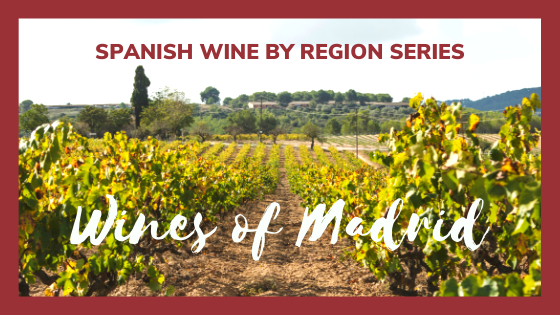SPANISH WINE BY REGION SERIES: WINES OF MADRID

As we continue discovering Spanish wine by region, we are heading to the heart of Spain: Madrid! In this installment we are going to talk about DO Vinos de Madrid, Wines of Madrid, the wine region in the the south of Madrid province. Let’s take a look at what makes this DO unique and the wines that come from it.
Sub-zones of Wines of Madrid
 DO Vinos de Madrid, or Wines of Madrid, became a certified DO in 1990. The region has three sub-zones, which all have a similar climate. This wine region has summers that are long and hot, with winters that are quite cold. It’s relatively dry, with most precipitation occurring in the fall. The three sub-zones are as follows.
DO Vinos de Madrid, or Wines of Madrid, became a certified DO in 1990. The region has three sub-zones, which all have a similar climate. This wine region has summers that are long and hot, with winters that are quite cold. It’s relatively dry, with most precipitation occurring in the fall. The three sub-zones are as follows.
- Arganda is east of the city of Madrid and is most known for its Tempranillo wines. It has sedimentary limestone soil that helps foster the grapes to produce its wines. Of the three sub-zones, it’s the biggest, stretching from Arganda del Rey to Aranjuez. Inside this sub-zone there are 27 wineries, which together produce 20 million liters of wine annually. This regions accounts for half of the total wine production of the DO.
- Navalcarnero is in the southwest, where the loose sedimentary soil produces a variety of grapes. It’s the smallest of the three sub-zones, and accounts for about 20% of production. There are 5 wineries here that process grapes from 19 municipalities in the DO.
- San Martín is the third sub-zone of Wines of Madrid that accounts for 30% of the region’s production. Also, the Alberche River that runs through the region helps to protect from harsh weather and cold winds, resulting in a more humid climate. There are 12 wineries in San Martín that process grapes from 9 municipalities.
Grape varieties
The climate and conditions of the Wines of Madrid region allow it to grow numerous varieties of grapes. These are the authorized varieties that are grown in each sub-zone.
- Arganda: Tempranillo (recommended), Garnacha, Merlot, Syrah, Cabernet, Sauvignon (reds); Albillo, Moscatel, Malvar (recommended), Airén, Macabeo, Parellada, Torrontés (whites)
- Navalcarnero: Garnacha (recommended), Tempranillo, Merlot, Syrah, Cabernet Sauvignon, Syrah (reds); Albillo (recommended), Malvar, Moscatel, Airén, Macabeo, Parellada, Torrontés (whites)
- San Martín: Garnacha (recommended) , Tempranillo, Merlot, Syrah, Cabernet Sauvignon (reds); Albillo (recommended), Airén, Parellada, Macabeo, Moscatel, Torrontés (whites)
See more: Spanish Wine by Region Series: Rioja Wines
Classifications

Photo credit: Supersalomé on Visual Hunt / CC BY
There are 6 classifications of wines that come from the Wines of Madrid DO.
- Young wine: the wine has no aging.
- Crianza: wines that are aged for at least 2 years. 6 months of the aging process must take place in a wood barrel.
- Reserva: a minimum of three years of aging is required. For reds, at least one year is spent in an oak barrel, and six months for whites and rosés.
- Gran Reserva: at least 5 years of aging. A Gran Reserva must spend at least 2 years of the aging process in an oak barrel.
- Sobremadre: a special fermentation process. Sobremadre wines ferment with stemmed and crushed grapes, along with the must, to create a special gas. This unique process is mostly for white wines.
- Sparkling: bubbly. Sparkling wine can be white or red.
Join Food Lover Tour on a wine tour to really dive into the world of wine!

